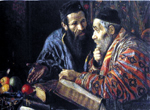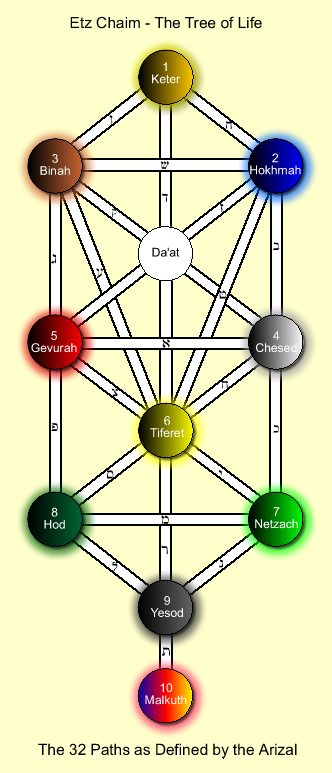


Before a grandson of the “holy Yehudi,” a zaddik of the seventh generation, a merchant brought a complaint against another who had opened a business next to him and reduced his profits. “Why,” asked the zaddik, “do you attach yourself so to the business by which you nourish yourself? What really matters is to pray to Him who nourishes and preserves! But perhaps you do not know where He dwells; now then, it is written, ‘Love thy fellow as one like thyself, I am the Lord.’ Only love him, your fellow, and wish that he too may have what he needs, - there, in this love, you will find the Lord.” (Ref. 1: Buber, p. 230)
Note to the student: The Rebbe, who was also expected to be and was recognized as a Tzaddik ("righteous one") was the leader of a spiritual community of disciples. But he (and in several cases she) was more than this, functioning for the village or town and its surrounding area as a localized messianic figure, able to intercede with God on the people’s behalf. People regularly came with petitions in hand seeking healing or assistance and advice in daily matters. The Rebbe was often asked to serve as a judge in matters of Halahkhic Law. With respect to the circle of disciples, however, the Tzaddik served mainly as the leader of prayer and as a teacher, and in both capacities was recognized as a holy intermediary, serving in the symbolic and literal capacity of Sefirah Yesod Ha-Olam ("Foundation of the World"), another name for which is Tzaddik ("the righteous one"). The Rebbe made use of various literary tools to convey the teachings brought down from the Ruach HaKodesh ("Holy Spirit") and in many cases from even higher authority. Among these tools are the parable, the tale, and the sacred anecdote, all of which are capable of reaching the inner levels of consciousness and understanding of common people. (Please note further that Hasidism, including Rebbes/Tzaddikim and living communities of disciples, still thrive throughout the world.)
We continue now with our discussion of this sacred Hasidic anecdote.
Commentary
In Part 2b of this lecture, we discussed the emptiness of modern life, of the futility of running after material things, of seeking to rise to a position of dominance over one’s fellow human beings. As Dovid Ha-Melech put it so very well:
"Children of men, how long will you be heavy of heart, why love what is vain and chase after illusions?" (Psalm 4:2)
God is the one source of happiness, the one source of meaning, the one source of sustenance, the one source of life.
We also discussed the way that God descends into the world; that is, the manifestation of the attributes and qualities of God through the Etz Chaim ("Tree of Life"), also known as the Ten Holy Sefirot. We described how these Ten Sefirot contain, transmit and receive the transcendental forces that underlie and sustain all existence, both in the Upper Worlds and the Lower World. Without these transcendental forces, transmitted through the twenty-two paths (or channels) linking the Ten Sefirot, the Tree of Life would cease to exist. Without them, Malkhuth ("Kingdom"), the lowest of the Ten Sefirot, would receive no nourishment to pass on to this temporal universe of material forms and names. But as we said previously, the universe is not a clockwork machine that God made and set in motion, after which He then walked away.
The Sustenance of the World through Shefa Ha-Berakhah
The Kabbalistic sages teach us that the world is sustained only by God’s continual and constant attention and blessing. The phrase they constantly use is:
vfrc-v gpa (Shefa Ha-Berakhah, "Abundance of Blessing")
Shefa is translated literally as "abundance" or "overflow." But the sages tell us it also means "influx." Berakhah is translated literally as "blessing" or "prosperity."
"Because there is nothing new under the sun, only the abundance of blessing which come from the Source of Life and from the Spring which blesses all things, every day and every hour and at every time, in order to establish and sustain them in the proper way. … And this is what is said in the liturgy: ‘In His goodness He renews every day the Works of Creation.’ ‘His goodness’ refers to the drawing down of blessing, which is the attribute of His goodness which ceaselessly comes from ‘Ein-Sof to sustain the works of Creation, for were it to cease for an hour or even a moment, it [the world] could not exist." (Ref. 2: R. Asher ben David)
Notice that Rabbi Asher ben David speaks of the "drawing down of blessing." If God’s Goodness ceaselessly "comes from ‘Ein-Sof (the Eternal) to sustain the works of Creation," and "were it to cease for an hour or even a moment" Creation "could not exist," why then must that divine overflow be "drawn down" into the Lower World of Creation? Is that not a contradiction? No. Joseph Gikatilla, a great Spanish Kabbalist contemporary to, but teaching from a different perspective than, Moshe de Leon, the redactor of Sefer Ha-Zohar, teaches:
"In the beginning of creation, the core of the Shekhinah was in the lower regions. And because the Shekhinah was below, heaven and earth were one and in perfect harmony. The well springs and the channels, through which everything in the higher regions flows into the lower were still active, complete and unhindered, and thus God filled everything from above to below. But when Adam came and sinned, the order of things was turned into disorder, and the heavenly channels were broken." (Ref. 3: Joseph Gikatilla, f. 9a)

Thus, the structure of the Godhead and the channels through which God’s Holy Shefa flowed to nourish the Shekhinah (Sefirah Malkhuth) were damaged by the sin of Adam. (We will not go into what that sin was in this lecture). As a result of Adam’s sin, the Tree of Knowledge of Good and Evil was separated from the Tree of Life. Heaven and earth were no longer one and in perfect harmony; nor did the well springs and channels any longer convey God’s Abundance of Blessing on their own. Where once was balance and harmony, now was imbalance and discord.
It now falls to Adam’s descendants to rectify the damage he did to the Godhead and to the universe. This is one of the key meanings behind the concept of tikkun olam ("repair of the world"). In Hasidic communities this task largely fell to the Rebbe, the Tzaddik, who was seen to stand in the light of Sefirah Yesod/Tzaddik. He acted as an earthly version of the Ninth Sefirah, a mediator between the Upper and Lower Worlds whose reduction of his own ego to a state of Ayin ("nothingness") enabled him to become an empty vessel capable of receiving the Shefa, the divine influx of God, which he would then transmit to his community.
But all of us are capable of doing this to some degree. We are all made in the image and likeness of God. As we have just learned, that image and likeness currently is one of disequilibrium, of discord. The qualities of God are no longer arrayed in balanced opposition to each other – not in the Godhead, not in the world, nor in us as individual human beings. Rather, they are blended together, like mixed up with unlike. It is up to us to untangle this blended group of opposites, to sort them out into their opposites. This "sorting out" is a process that must begin with each individual. Indeed, it cannot begin in the world or in the Godhead except in reflection and response to its being already underway in us.
As we begin this "sorting out" within our own being or psyche, then we can also begin to draw down the abundance of God’s blessing, into us and into the world. Just as the Tzaddik emulates the Sefirah Yesod, each one of us, through meditation, imagination and prayer, can activate the Imago Dei ("image of God"), or image of the Godhead (Ten Sefirot) that is stamped in our hearts. When we do this with proper kavvanah (mystical intention) we can cause the Holy Shefa to flow into our hearts, vivifying and sustaining us. And as we do this, nourishment from the Upper World begins to flow anew into the Lower World, for as we are taught "As below, so above."
As the great systematic Kabbalist Rabbi Moshe Chaim Luzzatto (1707 – 1746) stated:
"God arranged things so that every matter falling within the realm of man’s free will should be able to affect the transcendental Forces through this indeterministic influence according to the measure and degree set forth by God. This is true not only of man’s deeds, but even of his speech and thoughts. … Every indeterministic influence, however, also results in deterministic influences. When the highest Forces are influenced by man’s free will, they in turn influence the physical things that are inherently linked to them." (Ref. 4: Derech HaShem, I:5:5-6)
So at last we come to understand the Tsaddik’s advice to the merchant in the sacred anecdote we are studying:
"Why," asked the zaddik, "do you attach yourself so to the business by which you nourish yourself? What really matters is to pray to Him who nourishes and preserves!"
Instead of seeing the situation as one of scarcity, the Tzaddik advises the merchant to see it as one of potential abundance. Instead of praying or scheming for a way to keep from sharing his business revenues with his competitor, the Tzaddik advises him to pray to El Hai, the Living God, the source of all life, the origin of all blessings and sustenance. God is infinite, and His blessings are infinite. By loving his competitor and praying for the nourishment of his competitor, the well springs and channels of nourishment will be opened — not only for the merchant’s competitor, but for the merchant as well. But make no mistake. Such opening of the channels to receive the divine influx of shefa will not occur if the merchant (or any of us studying this teaching) does so with the impure intention of manipulating God. It only works if one has the proper kavvanah ("mystical intention") of spiritually repairing the damage done to God and Creation by the sin of our ancestor Adam. This kavvanah only exists when we come from a place in our hearts of genuine love for God and love for our neighbor. And, believe me, God knows the difference.
In our next installment of this lecture, we shall discuss where God is to be found.
Baruch HaShem
Rebbe Yahoshua Nesher ben Yakov Leib (YaNYaL)
___________________________________
References
Image: Water Lilies , by Claude Monet
Biblical Scripture: The New Jerusalem Bible (New York, Doubleday, 1985).
Ref. 1: Martin Buber, Hasidism and Modern Man, Edited and Translated by Maurice Friedman, (New York: Humanity Books, 1988).
Ref. 2: R. Asher ben David, nephew of R. Isaac the Blind (ca. 1235), Perush Shem ha-Meforash le-Rabbi Asher ben David, ed. M. Chasida (mimeographed), in ha-Segulah, nos. 2-10 (Jerusalem, 1934, p. 10. As quoted by Gershom Scholem, On the Mystical Shape of the Godhead, (Zurich, Rhein-Verlag: 1962, English Trans. New York: Schocken Books, 1991), pp. 108-109..
Ref. 3: Joseph Gikatilla, vrut hrga (Shaarei Orah "Gates of Light"), Offenbach 1715. As quoted by Gershom Scholem, Major Trends in Jewish Mysticism, (New York: Shocken Books, 1954), p. 231.
Ref. 4: R. Moshe Chaim Luzzatto, Derech HaShem, trans. By Aryeh Kaplan, 6th Rev. Ed., (Jerusalem: Feldheim Publishers, 1997), pp. 80-83.
___________________________________
The Kabbalah of Rebbe YaNYaL
Today's Teaching
The Mitzvot of Love, Part 2c: "The Abundance of God's Blessing "
Torah Verses for Today’s Lesson: Ps. 104, Lev. 19:18
